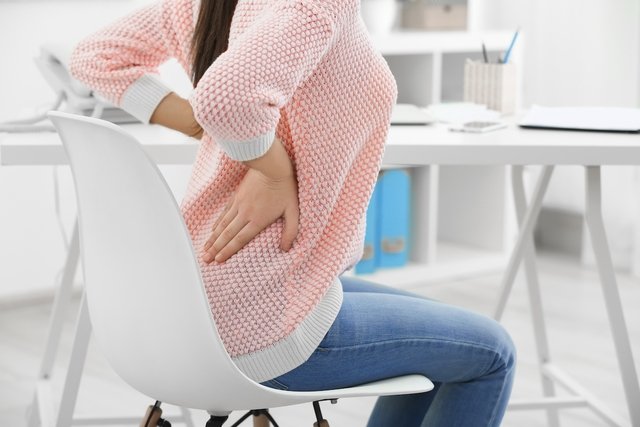To treat back pain, you can apply a hot water bottle to the area, relax and give a back massage, as this will promote greater blood circulation in the area, relax the local muscles and thus relieve pain. on the back.
However, in some cases, it may be necessary to use medications recommended by the orthopedist, such as anti-inflammatories or analgesics, in addition to physiotherapy sessions, to help reduce inflammation and relieve back pain.
Back pain can occur due to tiredness, stress, blows or be a consequence of hernia, aneurysms or fractures, it is important that the doctor is consulted so that tests can be carried out to identify the cause of the back pain and thus begin treatment. most appropriate. Discover the main causes of back pain.

10 ways to relieve back pain
Some tips on what to do to relieve back pain are:
1. Relax
One way to relax is to lie on your side or sit so that your back is completely against the chair for a few minutes, and avoid staying in the same position for a long time, whether sitting, lying down or standing.
By staying in a more comfortable position, you can breathe better and the muscle fibers loosen, relieving back pain.
When sleeping, to relieve back pain, the person can lie on their side or on their back, with their head well supported on a not too soft pillow. The ideal is to place another pillow under the knees, if the person is lying on their back, or between the knees, if they sleep on their side.
2. Apply heat
Applying a compress with warm water to the area of pain for 15 to 20 minutes can help relieve pain, as it improves blood circulation and relaxes the muscles, bringing pain relief in a few minutes.
So, to make this compress, simply wet a towel in warm water, squeeze it to remove excess water, and place it on the area of pain. You can also place the wet towel inside a plastic bag and wrap the bag with a dry towel, which is useful when the water is very hot or you don’t want to get your clothes wet, for example
You can also add 3 drops of basil or eucalyptus essential oil to the compress water, because these oils have anti-inflammatory properties, helping to relieve pain.
3. Massage the back
Having massages is also an option for relieving back pain, as it helps to reduce muscle tension and relax, improving pain.
One option is massage with essential oils, as depending on the oil used it is possible to have a greater feeling of relaxation and well-being.
4. Maintain a healthy weight
One of the causes of back pain is excess weight, which puts stress on the joints.
Therefore, following a detoxifying diet to eliminate toxins and excess fluids can be a good strategy to start with, but following a dietary re-education provides long-term and lasting results. See how to carry out nutritional re-education.
5. Reduce stress and anxiety
Stress and anxiety cause muscle tension, which often leads to a person having a sore back.
To provide relief, you can place 2 drops of lavender or macella essential oil on the pillow, as they have calming properties and promote sleep. Check out other essential oils for anxiety and how to use them.
6. Improve posture
Spending the day in the correct posture prevents back pain and also helps to alleviate the pain once it has already set in. As back pain is often caused by poor posture, doing some postural re-education sessions with a specialized physiotherapist can be of great help. See some exercises to improve posture.
7. Do physical exercise
After the symptoms of back pain have been relieved, it is very important that the person exercises regularly to prevent the pain from returning.
The physical education professional will be able to indicate the best modality, respecting your tastes and possibilities, but good options are walking and Clinical Pilates, done with the physiotherapist with exercises that strengthen the abdomen and lumbar spine, for example.
8. Stretch
Doing back stretching exercises can also relieve pain and muscle tension, as well as increase flexibility and mobility, improve circulation, reduce stress on joints, improve posture and promote well-being. Here’s how to do stretching exercises to relieve back pain.
9. Taking medicine
The use of medication may be recommended by the doctor when the pain is very intense and makes daily activities difficult. Back pain remedies can be found in the form of ointments and should be applied to the area of pain with a gentle massage until it is completely absorbed by the skin.
Some of the remedies that your doctor may recommend for back pain include:
- Analgesicssuch as Paracetamol, 3 times a day or as prescribed by a doctor;
- Anti-inflammatoriessuch as Ibuprofen, taken 3 times a day, or nimesulide, 2 times a day, after meals, especially in cases of arthritis;
- Muscle relaxantssuch as Miosan, 3 to 4 times a day or according to the orthopedist’s instructions;
- Diclofenac and Thiocolchicoside Injectionscarried out at the hospital or health center, as prescribed by the doctor.
Medicines reduce pain and inflammation, bringing pain relief, but to prevent pain from returning, it is advisable to also undergo physiotherapy sessions, which are useful for strengthening weakened muscles, improving posture and positioning of all structures.
10. Do physical therapy
Physiotherapy is interesting especially when the pain does not improve over time. Therefore, in physiotherapy sessions, stretching exercises are performed to keep the back structures well positioned and the muscles with ideal flexibility to carry out all day-to-day activities without pain.
Furthermore, physiotherapeutic treatment may vary from person to person and may include thermo-electro-phototherapy resources to relieve pain and inflammation, contributing to a better effect of medications, and in a more advanced phase it is generally necessary to perform appropriate kinesiotherapy exercises. to the patient’s reality and needs.
How to avoid back pain
Some ways to prevent back pain from returning are:
- Maintain good sitting posture to distribute body weight well;
- Exercise at least 3 times a week to keep your muscles strong and stretched;
- Lose weight if you are above the ideal weight to avoid overloading the spinal joints;
- Sleep with a low pillow; Do not carry too much weight, such as backpacks and heavy briefcases, for more than 10 minutes a day
- Avoid stress.
By following these guidelines, the individual’s chances of developing back pain will be considerably reduced. Here are some tips on how to maintain good posture.
When to go to the doctor
You should go to the doctor when your back pain takes a long time to go away or is very intense, making day-to-day tasks difficult. Furthermore, it is also recommended to go to the doctor when symptoms other than back pain appear, such as:
- Pain that radiates to the legs;
- Tingling or burning sensation in the back;
- Burning sensation in the buttocks;
- Difficulty walking.
Typically, the doctor carries out an assessment during the consultation and requests some imaging tests, such as X-rays or MRIs to evaluate the spine, intervertebral discs and spinous processes, for example, and check the need for medication, physiotherapy or, in the most serious and chronic cases, surgery.
When surgery is indicated
In more severe cases or when all therapies to relieve back pain have been tried without success, it may be necessary to undergo spinal surgery. Spine surgery is delicate and can have complications, but in some cases it is very necessary to combat the cause of back pain and thus eliminate the pain.
However, after spinal surgery, it is usually necessary to undergo some physical therapy sessions to recover and learn to maintain good posture.

Sign up for our newsletter and stay up to date with exclusive news
that can transform your routine!
Warning: Undefined array key "title" in /home/storelat/public_html/wp-content/plugins/link-whisper-premium/templates/frontend/related-posts.php on line 12
Warning: Undefined array key "title_tag" in /home/storelat/public_html/wp-content/plugins/link-whisper-premium/templates/frontend/related-posts.php on line 13




